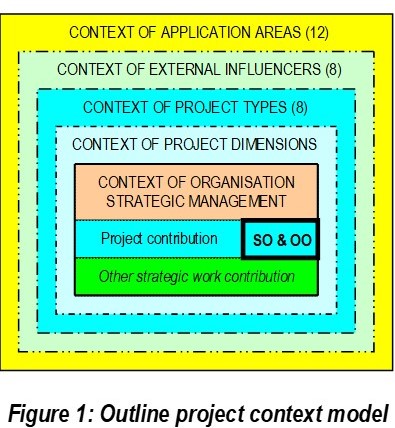Series on Project Contexts
By Alan Stretton, PhD (Hon)
Sydney, Australia
INTRODUCTION
This is the fourth of a series of seven articles which identify and discuss a variety of key contexts which impact on the management of projects. The basic reason for developing this series is that there is far too little attention given to the contexts of projects in the relevant literature – particularly when you consider that, in practice, effective management of projects’ contexts is usually quite critical to achieving overall project management (PM) success.
 The first article of this series (Stretton 2019e) identified six key types of project contexts. These were summarised pictorially into a combined model, depicted in skeleton format in Figure 1 to the left.
The first article of this series (Stretton 2019e) identified six key types of project contexts. These were summarised pictorially into a combined model, depicted in skeleton format in Figure 1 to the left.
The second article of this series (Stretton 2019f) was concerned with the context of organisational strategic management, and the third (Stretton 2019g) with the contexts of projects being undertaken by supplier organisations (SOs), and by owner organisations (OOs). This fourth article is concerned with the context of what Shenhar & Dvir 2007 describe as project dimensions. Its place in Figure 1 is illustrated by bolder typeface and a heavier outer border.
RECAPPING DISCUSSIONS OF THE CONTEXT OF PROJECT DIMENSIONS IN THE FIRST ARTICLE
I discussed aspects of this context in Stretton 2019e, under the following headings.
The NTCP model of Shenhar and associates
NTCP is shorthand for what Shenhar and colleagues describe as the four project “dimensions” of Novelty, Technology, Complexity, and Pace. In Shenhar et al 2016 these are described as follows.
NOVELTY: Market Innovation – How new is the product to the market, users, and customers.
TECHNOLOGY: Technological Innovation – How much new technology is used
COMPLEXITY: Level of System Innovation – Represented by the complexity of the product or the organization.
PACE: Urgency of the Innovation – How critical is your time frame.
In the last version of the NTCP model that I know of (Shenhar et al 2016), each of the four dimensions has four levels, as indicated in Figure 6. The heavily outlined diamond illustrates a project with rather low levels of each of the Novelty, Technology, Complexity and Pace dimensions.
More…
To read entire article, click here
How to cite this article: Stretton, A. (2019). Title, Series on Project Contexts, article 4; PM World Journal, Volume VIII, Issue VIII, September. Available online at https://pmworldlibrary.net/wp-content/uploads/2019/09/pmwj85-Sep2019-Stretton-4-context-of-project-dimensions-series-article.pdf
About the Author

Alan Stretton, PhD
Faculty Corps, University of Management
and Technology, Arlington, VA (USA)
Life Fellow, AIPM (Australia)
![]()
Alan Stretton is one of the pioneers of modern project management. He is currently a member of the Faculty Corps for the University of Management & Technology (UMT), USA. In 2006 he retired from a position as Adjunct Professor of Project Management in the Faculty of Design, Architecture and Building at the University of Technology, Sydney (UTS), Australia, which he joined in 1988 to develop and deliver a Master of Project Management program. Prior to joining UTS, Mr. Stretton worked in the building and construction industries in Australia, New Zealand and the USA for some 38 years, which included the project management of construction, R&D, introduction of information and control systems, internal management education programs and organizational change projects. He has degrees in Civil Engineering (BE, Tasmania) and Mathematics (MA, Oxford), and an honorary PhD in strategy, programme and project management (ESC, Lille, France). Alan was Chairman of the Standards (PMBOK) Committee of the Project Management Institute (PMI®) from late 1989 to early 1992. He held a similar position with the Australian Institute of Project Management (AIPM), and was elected a Life Fellow of AIPM in 1996. He was a member of the Core Working Group in the development of the Australian National Competency Standards for Project Management. He has published over 200 professional articles and papers. Alan can be contacted at alanailene@bigpond.com.au.
To see more works by Alan Stretton, visit his author showcase in the PM World Library at http://pmworldlibrary.net/authors/alan-stretton/.









